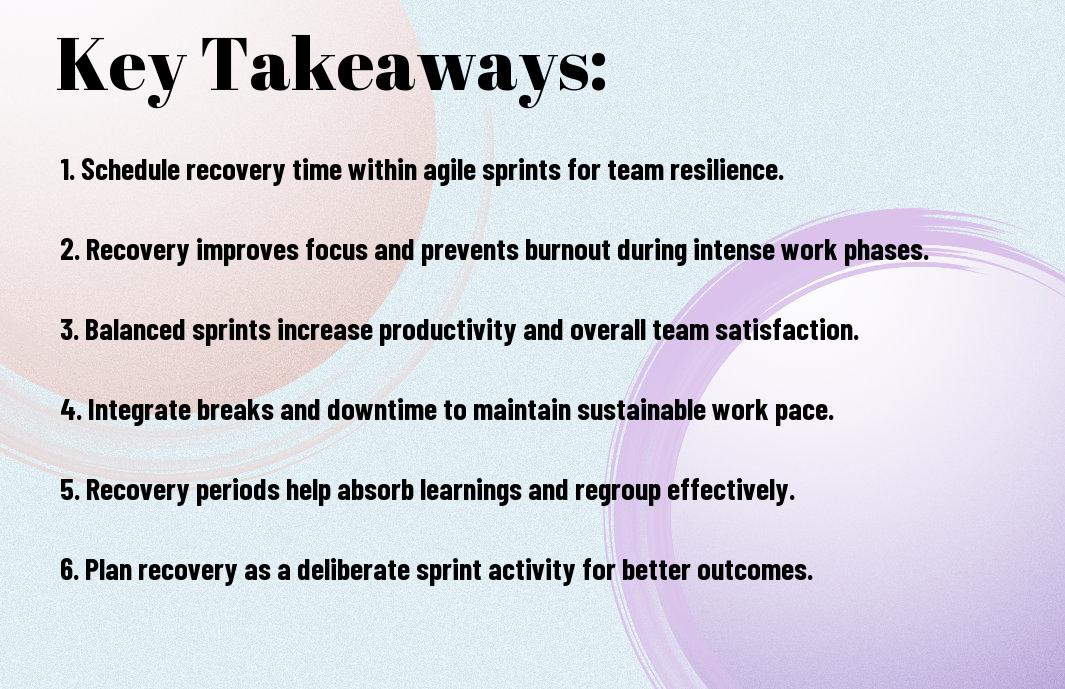Over the course of your projects, you may notice that sprint cycles can often lead to burnout if recovery time isn’t effectively integrated. By designing recovery periods into your sprints, you can enhance your team’s productivity and creativity while reducing stress. Prioritizing downtime can improve overall performance and foster a more sustainable work environment. This post will guide you through actionable strategies to implement recovery time effectively, ensuring both you and your team can thrive without sacrificing performance. Let’s transform how you approach sprint planning for better results.
Key Takeaways:
- Integrating recovery time into sprints enhances overall team productivity and creativity, allowing for more effective work cycles.
- Taking breaks during intensive work periods can prevent burnout, ensuring that team members maintain mental and physical well-being.
- Flexible sprint planning that includes scheduled recovery can improve project outcomes by fostering a sustainable work environment.

The Necessity of Recovery in Agile Environments
In Agile environments, sprinting without adequate recovery can lead to burnout and diminishing returns on productivity. Your team relies on quick iteration to effectively respond to changing requirements, but it’s important to balance speed with the need for mental and physical recuperation. Implementing recovery time fosters resilience, enhances creativity, and ensures that your team can sustain high levels of performance over the long term.
Mental and Physical Impacts of Sprinting
Engaging in rapid sprints can strain both your mental and physical resources. The heightened stress levels from continuous work often lead to fatigue, reduced cognitive function, and even chronic health issues. Shifting focus from deadline pressure to incorporating regular breaks and wellness activities can help mitigate these impacts, ultimately leading to a more sustainable work environment.
The Role of Recovery in Enhancing Performance
Integrating dedicated recovery periods into your sprint cycles can significantly enhance overall performance. Research indicates that teams allowing for strategic downtime experience higher engagement levels, creativity, and problem-solving skills. For example, a study by Stanford University found that productivity drops sharply after you work more than 50 hours a week, highlighting the need for regular intervals of rest to sustain success.
Incorporating recovery isn’t just about rest; it’s about leveraging moments of downtime to recharge your team’s energy. Consider implementing practices like mindfulness sessions, brief walking meetings, or collaborative breaks after intense work. These simple strategies foster better communication and camaraderie among team members, promoting a more energetic atmosphere that can lead to innovative solutions. Drawing on experiences from leading Agile companies demonstrates that teams prioritizing recovery consistently outperform counterparts that do not. Your commitment to recovery allows for enhanced focus, leading to a collaborative and innovative environment, ultimately ensuring sustained success in your Agile processes.

Designing Recovery Time: Strategies That Work
Structuring Sprints with Purposeful Breaks
Integrating purposeful breaks into your sprint schedule enhances productivity and creativity. Instead of continuous work sessions, consider implementing the Pomodoro Technique—25 minutes of focused work followed by a 5-minute break. This rhythm helps maintain momentum while reducing fatigue. Additionally, you might allocate time for *longer breaks* every two hours, where team members step away from screens to recharge. Such intentional structuring ensures that recovery time is built into your workflow, allowing you to maintain focus and energy throughout your sprints. Learn more about effective sprint techniques at The Design Sprint — GV.
Implementing Mindfulness and Rest Techniques
Incorporating mindfulness and rest techniques during sprints can significantly improve your team’s overall well-being and effectiveness. Simple practices, such as guided meditation or stretching sessions, can create a calming environment and foster a sense of community. Encourage your team to set aside a few minutes for deep breathing exercises or a quick walk outdoors to clear their minds. These moments of reflection not only aid recovery but also spur creative problem-solving.
Dedicating time to mindfulness enhances your team’s ability to handle stress and navigate challenges during sprints. You might introduce a *brief guided meditation* before meetings to center everyone’s focus or share resources for apps that promote relaxation. Studies show that these approaches lead to better decision-making and heightened productivity. By embedding mindfulness into your sprint culture, you help nurture a positive atmosphere that embraces recovery as a pathway to creativity and project success.
Balancing Productivity and Well-being
Striking the right balance between productivity and well-being is vital in any agile environment. It’s tempting to push limits for short-term gains, but the long-term consequences can be detrimental. Understanding how to accurately gauge team capacity is pivotal for maintaining this balance. Engaging discussions about workload management can be found in forums, such as How do you determine how much work can get done in a sprint?
Evaluating Team Outputs vs. Burnout Risks
A constant focus on output can lead teams to overlook signs of burnout. It’s vital to maintain a pulse on both performance metrics and individual well-being. Prioritize regular check-ins to understand how team members feel. By fostering open communication, you’re more likely to spot red flags and adjust workloads accordingly, ensuring sustained productivity without compromising mental health.
The Cost of Ignoring Recovery: A Data-Driven Perspective
Neglecting recovery periods can drastically escalate costs related to turnover, healthcare, and diminished productivity. Studies show that teams lacking recovery time experience up to 50% increased turnover rates. Moreover, the financial impact of decreased productivity due to burnout can exceed $300 billion annually in lost productivity in the U.S. alone. This data signals a compelling case for embedding recovery into your sprints.
Ignoring recovery not only affects employee morale but can also lead to significant operational deficits. For example, a study by Gallup found that teams who regularly engage in recovery periods are 20% more productive than those who do not. Meanwhile, a staggering 60% of employees report burnout, linking it to higher absenteeism and reduced job satisfaction. With these insights, investing in recovery time emerges as a pragmatic strategy that could enhance your team’s overall performance while safeguarding their well-being.
Cultivating a Recovery-Oriented Culture
Fostering a recovery-oriented culture requires a shift in mindset across the entire organization. You must prioritize recovery just as you do deadlines and deliverables. Embracing flexibility in your processes allows team members to adequately recharge. Promote regular check-ins and open discussions about burnout and mental health, laying the foundation for a supportive environment. Celebrating recovery and well-being as part of your team’s success not only reinforces these ideals but also enhances overall productivity and morale.
Leadership’s Role in Prioritizing Recovery
Your leadership acts as a guiding force in establishing a recovery-oriented culture. By openly advocating for time off and encouraging team members to prioritize well-being, you create a safe space for rest and rejuvenation. When leaders model balance and recovery in their own work habits, it sets a powerful example for the team. This can be achieved through transparent communication about workload expectations and demonstrating that taking breaks enhances long-term productivity.
Encouraging Team Buy-In: Strategies for Success
Gaining team buy-in for a recovery-focused approach relies on clear communication and active participation. Start by involving team members in discussions about recovery strategies, allowing them to voice their concerns and suggestions. Regular workshops or informal sessions dedicated to well-being can facilitate greater understanding and ownership. Consider rewarding teams that successfully integrate recovery practices into their sprints, showcasing tangible benefits like improved mental health and project outcomes.
To effectively engage your team in the recovery conversation, initiate brainstorming sessions that focus on identifying specific recovery strategies that resonate with them. Data-driven approaches, such as tracking team health metrics or presenting studies that link recovery to enhanced performance, can solidify your case. You might implement peer-support programs or wellness challenges to encourage camaraderie while focusing on well-being. Ultimately, fostering a collective responsibility for recovery not only strengthens trust within the team but also cultivates a culture of care that elevates everyone’s performance.
Future-Proofing WorkWell: Adapting Recovery Approaches
Maintaining a sustainable work environment involves proactively adapting recovery strategies to meet evolving challenges. Organizations face increasing demands, necessitating a flexible approach to recovery that offers varied options based on individual and team needs. By integrating mindfulness practices, flexible schedules, and wellness workshops into the work culture, you can enhance productivity without sacrificing employee wellbeing. Tailoring these strategies to your unique work environment ensures that recovery becomes an integral part of your organizational fabric.
Leveraging Technology for Enhanced Recovery
Utilizing technology can significantly boost your recovery efforts. Tools such as wellness apps, virtual relaxation sessions, and AI-driven productivity analytics can not only track your recovery time but also identify patterns that may lead to burnout. Whether it’s an app that nudges you to take breaks or virtual team-building activities that promote peer support, adopting these tools enhances your ability to recover while keeping your engagement levels high.
Trends in Workplace Recovery Practices Post-COVID
The COVID-19 pandemic has fundamentally reshaped workplace recovery practices. Many companies now prioritize mental health and wellness, leading to an increase in remote work and flexible schedules. Research shows that 76% of employees prefer hybrid models that allow personalized recovery strategies. Organizations are also focusing on building a culture of transparency around mental health, creating dedicated resources, and introducing training on stress management, all to foster a healthier workplace post-pandemic.
As employees seek greater work-life balance after the pandemic, effective recovery practices have become a competitive differentiator. Companies are investing in comprehensive wellness programs that not only address physical fitness but also target mental well-being through counseling services and mindfulness training. Many are taking it a step further by offering unlimited vacation days, fostering an atmosphere where employees feel supported and empowered to take the time they need for their well-being. Integrating these practices can enhance job satisfaction and reduce turnover, ultimately leading to a more resilient workforce.
Conclusion
The concept of integrating recovery time into your sprints with WorkWell can transform your work approach, fostering both productivity and well-being. By prioritizing breaks and ensuring adequate rest periods, you empower yourself to maintain high performance without succumbing to burnout. This thoughtful consideration of your recovery not only enhances your focus but also boosts creativity and overall morale. Embracing this methodology allows you to achieve sustainable results, ensuring your efforts contribute meaningfully to your goals over time.
FAQ
Q: What is the primary goal of implementing recovery time into sprints with WorkWell?
A: The primary goal of incorporating recovery time into sprints with WorkWell is to enhance team productivity and overall well-being. By intentionally scheduling breaks and recovery phases, teams can avoid burnout, maintain high levels of creativity, and ensure that they are operating at their best. This approach promotes sustainable work habits and allows for more effective collaboration and problem-solving within the team.
Q: How can teams effectively integrate recovery time into their existing sprint planning using WorkWell?
A: To effectively integrate recovery time into sprint planning, teams can start by evaluating their current workload and identifying periods of high intensity. WorkWell provides tools and frameworks to help teams balance their sprint goals with appropriate breaks and downtime. Teams can allocate specific time blocks for recovery activities and employ techniques like time-boxing or retrospective planning to adjust workloads and incorporate regular check-ins to assess team energy levels. This integration ensures that recovery is viewed as an crucial part of the work process rather than an afterthought.
Q: What are the potential benefits that teams can expect from utilizing WorkWell for recovery time in sprints?
A: Teams utilizing WorkWell for recovery time in sprints can expect numerous benefits, including improved mental and physical health, increased focus, and enhanced job satisfaction. By acknowledging and addressing the need for recovery, team members are likely to experience lower stress levels, leading to better performance and higher quality work. Additionally, the overall team dynamic can improve, as a culture of care and support evolves, fostering collaboration and innovation. This proactive approach to managing workload and recovery ultimately leads to more successful project outcomes.

Leave a Reply